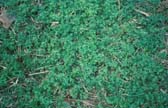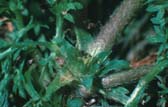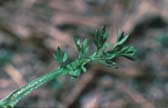
Lawn Burweed – It’s a Stick Problem
Tim R. Murphy – Retired Extension Weed Scientist, The University of Georgia
Edited from a longer article you can find here.
The weed in question is most commonly lawn burweed (Soliva pterosperma), a.k.a. spurweed, stickerweed, sandbur, sanbur and sandspur. Lawn burweed is a winter annual member of the Aster family. The weed germinates in the early fall months as temperatures cool and remains small or inconspicuous during the cold winter months. However, as temperatures warm in the early spring, or about the same time as spring sports activities, lawn burweed initiates a period of rapid growth and begins to form spine-tipped burs in the leaf axils. The sharp-tipped spiny burs of this weed can irritate the skin.
Key identification characteristics of lawn burweed are:
- opposite, sparsely hairy leaves that are divided into numerous segments, or lobes
- small, inconspicuous flowers, and c) spine tipped burs that are found in the leaf axils (junction of leaf and stem).
- attains an overall diameter of up to 6 inches and a height of about 3 to 4 inches.
- It is commonly found in the Coastal Plain and Piedmont regions of Georgia.


Lawn burweed is easily controlled during the winter months.
December, January and February are ideal months to apply herbicides to control this weed. Lawn burweed is small and easier to control at this time of the year than in April and May. Also, turfgrasses are not actively-growing during the winter months and have better tolerance to some herbicides.
See the UGA Pest Management Handbook for pesticide recommendations for your turf type. Two to three weeks after the initial application, lawn burweed control should be evaluated. If control is not acceptable, an additional application may be necessary.
Lawn burweed can be controlled in late-March, April and early May, however, two main facts should be considered.
- Lawn burweed begins to die as late spring temperatures approach 90° F and the plant is harder to control once the spiny burs or stickers have formed. Multiple herbicide applications are usually necessary, which increases the risk of temporary injury to the turfgrass.
- Additionally, it takes time for the herbicide to control lawn burweed, and after death, it takes time for the dead lawn burweed plants to decompose. Therein lies one of the main problems with late treatments. Dead lawn burweed plants contain dead, or brown spine-tipped burs. Dead or alive, the spiny burs still present a problem. The only recourse at this point is to allow time for the plant to naturally decompose.
For more information:
Find pesticide recommendations – UGA Pest Management Handbook